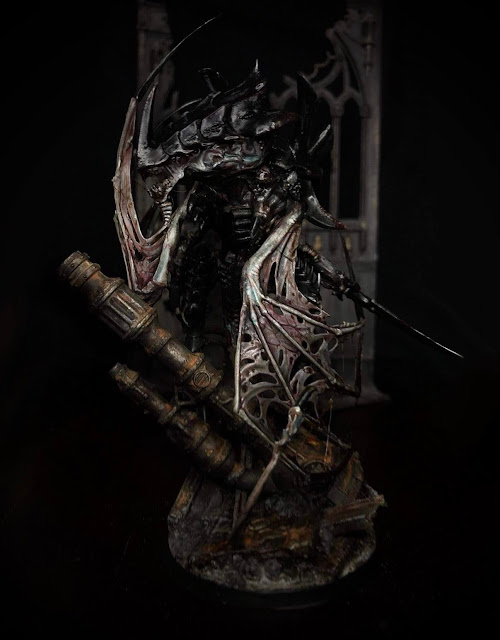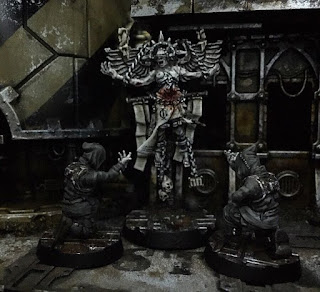Tyranids, Tyrants & Tutorials
During late 4th edition, I was convinced by a friend to try out Warhammer; I knew from the start that I wanted an army of dragons, but after an afternoon browsing my local GW, I found that High Elves were the only dragon-themed army, and none of my friends played WHFB. So, I found a box of Tyranid gaunts which I decided were close enough, painted them neon green and stuck a chaos shield on one of them. As a year or two went by and the edition changed, I had amassed around 5000 points of Tyranids. The new codex at the time introduced a number of new characters that didn’t have models, so to create them, I was forced to learn how to convert and scratch build.
As
I became more grounded in my hobby and improved as a painter, I knew I wanted
to return to the Tyranids one day. I love their lore, their artwork and most of
their miniatures. I tried to repaint some of my older stuff, but I was never
able to escape those garish colours and super glue-oozing builds.
In
2019, I had a brush again with the Tyranids; I made a large Genestealer Cult
army inspired by Alien Covenant and the Alien franchise in
general. I kept most of it pretty “low-fantasy”, focused on a tiny Imperial
colony encountering Tyranid spores trapped in the glaciers on their planet. Eventually,
the colony produces a Patriarch (the one Tyranid miniature I made for the army,
as per my self-imposed rule, while the humans still remain as humans, believing
the Patriarch to be the Emperor reborn.
You
can read all about this colony here.
The
Genestealer Cult work really nicely for the scale of army building that 40k encourages
(between 40-100 or so models), and they also fit the horror theme of my
projects. Keeping the Tyranids at a minimum also helped maximise the horror by
not oversaturating the narrative with them.
Despite
this, however, the story of Escarr and the Genestealer Cult continued in my
head long after I finished the project, but doing a full army of Tyranids
seemed like treading on the holy ground of my first army. I continued with the
narrative still though, creating a Deathwatch Space Marine and Inquisitorial
Agents who have come to Escarr in the aftermath of the colony’s turn to the
Hive Mind. There, the Deathwatch found a world of ruined settlements, men
strung up and crucified to Imperial Aquilas, their chests ripped open—and the
diaries and data logs, pages filled with maddened ramblings and tales of
monstrous births. Eventually, assuming the work of a witch cult, the Ordo
Hereticus was summoned…
As
the narrative grew, more Tyranids were grown from the offspring of the
Patriarch. As these Tyranids evolved and adjusted their evolutionary path stabilised,
and they came to resemble the standard Tyranid bio-forms. Despite this, there
were many irregularities, as they took on elements of their hosts, growing
human skulls, teeth and eyes across their bodies, as well as being able to
mimic human screams, which they used to attract the sympathy of their prey.
So,
there’s the lore reason for more Tyranids. And also the reason I don’t have to
do thousands of gaunts. Tyranids have always felt too big in scale for standard
40k, especially at the 1000 point scale I like to play at, so using some
inspiration from The Anphelion Project book, I worked out a reason to just
make the bugs I wanted to.
Also,
I had a really cool idea for a Hive Tyrant.
` The
model was inspired by the old Forge World Hive Tyrant and the cover artwork for
War Zone Octarius 1, as well as the Anphelion Project in general.
I’d developed by own aesthetic taste for the Tyranids through these sources
as well as the alien franchise, keeping a Pinterest board on the army for the last
year or two. I often do this for months or even years ahead of a
project, meaning I’ve got a good chunk of ideas and references the second I’m
ready to start on the project.
When
GW released the Vengorian Lord miniature, and I made my Terrorgheist using it, I
knew they’d become my new go-to monster wings in the future. When I wanted to
make a savage and animalistic Hive Tyrant, I knew exactly where to turn to for
bits. While the Vengorian wings replaced the Hive Tyrant’s, I also used its
tail to replace much of the base model’s too, giving it a more lithe and
lizard-like appearance as it curls around the terrain. The Zoanthrope head is a
more popular conversion that I also wanted to try; having the Tyranid have no
eyes makes it much scarier and Alien. I did replace the Zoanthrope’s jaw,
however, with that of the original Hive Tyrant, as though it is shrieking, as
well as adding back its horn. The bonesword was converted and reposed to make
it appear as an extension of the Hive Tyrant’s limb, a blade of chitin
macheteing through the flesh, rather than a sword it is holding, giving it a
more animal-like appearance vs the almost humanoid stock model. I did the same
with the lash whip; no longer is the Hive Tyrant holding a coiled tendril, but
it’s instead a single whipping tentacle extending from its body.
A lot of my models usually have metallic surfaces on them, but the Tyranids obviously wouldn’t, being organic organisms. To contrast the pale skin and to ground the Hive Tyrant in the ‘real’ world however, I mounted it as though leaping or resting on a Sector Mechanicus smoke stacj. This also helped add to the height and made it fit more snugly and satisfyingly on the base. It feels more like a swarm leader this way.
This model has definitely been one of my most-requested to make a painting tutorial for, and I started working on the Ripper Swarms to make one, but stopped for a couple of reasons: first of all, the models are too small to properly showcase the different layers and transitions; second, I thought it would be a slightly unfair tutorial to make, seeing as the first half is inspired strongly by The Grimdark Compendium’s Grimdark Flesh tutorial here. I followed the first part of this tutorial and start the second half here, but stopped after painting the red veins (but I used a darker red instead). After this, instead of airbrushing the model with more Dead Flesh, I glazed the raised surfaces of the model with very watered-down Pallid Wych Flesh. This obscured the veins and created the illusion of overlapping layers of skin without muddying the recesses with white. After this, I darkened the recesses further with Agrax Earthshade, mixing in a little black onto the model while it is halfway drying to make the deepest parts of the model appear as though they are in pure shadow. I then edge highlighted the focal points of the model with more Pallid Wych Flesh before black lining and painting the carapace with black oils and finally spraying the model with gloss varnish. After
this, I added blood and vomit effects as well as pigments to the base.
So
far, using these methods, I’ve painted my Hive Tyrant and three Forgeworld
Ripper Swarms. I converted these lightly by filling in the eyes with Milliput
to add to the facehugger/ Alien look. This was a simple, yet grinding process,
that I don’t feel terribly excited to repeat any time soon, despite how cool I think
they turned out.
All
in all, this has been a fun, yet slightly grindy, project to work on. The Hive
Tyrant took six months of scattered work from build to finish. I kept
reinventing the base recipe, and the oil paints’ drying times made it so I could
never complete more than a step or two in one evening, though I think the end result
is worth it.
I’m
really satisfied with the finished model, and I really do want to do some more.
I’m eyeing up the Parasite of Mortrex and some Carnifexes (Carnifexi?) on the
GW website as I type.
To
follow my hobby journey and see what other models and monsters I paint, follow
me on Instagram @theempyrean_
Thanks
for reading!










This comment has been removed by the author.
ReplyDeleteCool
ReplyDelete